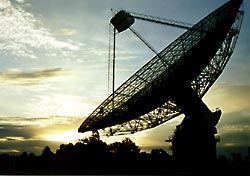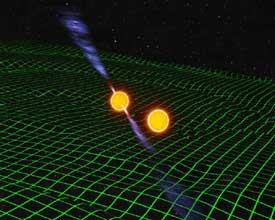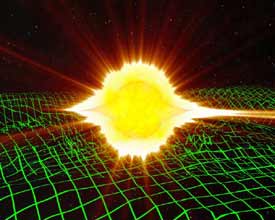
The new binary neutron system was discovered with the 64-meter Parkes radio telescope in New South Wales, Australia.
Photo by John Sarkissian / CSIRO.
An international team of astronomers has discovered the sixth known binary consisting of two neutron stars — collapsed stellar cores that cram about 1.4 solar masses into spheres about the size of a city. The two stars of the newly discovered binary orbit each other more closely than the previously known systems, so they provide astronomers with a golden opportunity to test Einstein's general theory of relativity to high levels of precision.
The newly discovered system is named PSR J0737-3039 for its sky coordinates just off the tail of Canis Major. One of the neutron stars is a pulsar; it emits radio pulses at regular intervals as it spins 45 times per second. The international team, led by Marta Burgay (University of Bologna, Italy), found the system during an ongoing pulsar search with the 64-meter Parkes radio telescope in Australia.

A symbolic depiction of the newly discovered neutron star binary system. In reality, the two stars are separated by some 3,000 times their diameters. The neutron star on the left emits a rotating beam of radio waves, lighthouse-style, seen here in blue. The two objects produce ripples in the fabric of space-time as they revolve around each other. Click for animation.
Courtesy John Rowe Animation.
The pulses appear to speed up and slow down slightly as the pulsar swings around its companion. By analyzing this effect, Burgay's team determined that the system contains 2.58 solar masses, which is split nearly evenly between the two objects. The other neutron star does not beam radio pulses toward Earth, so it remains unseen except for its gravitational influence. The two objects revolve at a breakneck 300 kilometers per second, making them among the fastest moving stars in our galaxy. They trace a slightly elliptical path around a common center of mass every 2.4 hours, separated by an average distance of 800,000 kilometers — slightly more than twice the Earth-Moon distance.
Astronomers and physicists are licking their chops at the prospect of studying this system. Neutron stars have large masses but small sizes, so they provide very clean testbeds for studying key predictions of general relativity, Einstein's theory that equates gravity with the curvature of space-time. Binary neutron stars in particular allow scientists to observe relativity's subtle effects on orbital motion because the extreme clocklike regularity of a pulsar's radio blips can reveal minuscule changes in orbital parameters. But only two of the five previously known systems allowed for precise tests of general relativity. This one provides the best opportunity of all because the small separation maximizes relativistic effects.
Joseph Taylor (now at Princeton University) and Russell Hulse (now at the Princeton University Plasma Physics Laboratory) shared the 1993 Nobel Prize in physics for their 1974 discovery and subsequent analysis of the first known binary neutron star. After monitoring the system for several years, Taylor and Hulse found that the two objects are slowly spiraling inward. According to general relativity, the two neutron stars should draw nearer at exactly the observed rate because they lose orbital energy by emitting gravitational waves — subtle ripples in the fabric of space-time that travel at the speed of light.
Gravitational waves are normally so extraordinarily weak that scientists have never detected them directly. Yet they are such a linchpin of general relativity that the theory would crumble like a house of cards in a hurricane if they did not exist. Taylor and Hulse's observations of the binary neutron star provided compelling indirect evidence that they do.

In 85 million years the two neutron stars will collide and merge, producing a powerful burst of gravitational waves that will disturb the fabric of the surrounding space-time.
Courtesy John Rowe Animation.
Based on the predicted rate of orbital decay, the two neutron stars in PSR J0730-3039 will collide and merge in only about 85 million years. In the final minutes before and during the merger, the system will emit very powerful gravitational waves. Current detectors, such as the Laser Interferometry Gravitational-Wave Observatory (LIGO) in Louisiana and Washington, VIRGO in Italy, and GEO600 in Germany, could register such an event at distances up to 60 million light-years, the distance to the Virgo Cluster of galaxies.
According to the most optimistic previous estimates of neutron-star merger rates, these gravitational-wave detectors might see roughly one event per decade. But the discovery of the new binary system improves the odds. Calculations by Vicky Kalogera (Northwestern University), Chunglee Kim (Northwestern University), and Duncan Lorimer (University of Manchester) increase the estimated merger rate about sixfold. "Under the most favorable distribution model, we can say at the 95 percent confidence level that the first generation of gravitational-wave detectors could register a neutron star merger every one or two years," says Kalogera.
Kalogera and her colleagues base their estimate on two characteristics of the new binary system. First, the source was difficult to detect despite its relative nearness of 1,600 to 2,000 light-years. This implies the existence of many other binary neutron stars that have yet to be found. Second, the neutron stars will merge much sooner than the five previously known binary systems, meaning there are probably many others that will merge on even shorter timescales.
"This discovery is good news for [gravitational-wave] astronomers," says discovery team member Andrew Lyne (University of Manchester). "It may be possible to study these cosmic catastrophes every few years, instead of having to wait half a career."
Although the gravitational wave emission from PSR J0737-3039 is too feeble to be detected directly even by LIGO, observers should be able to detect orbital decay due to gravitational-wave emission in about 15 months. Burgay's team has already detected another effect of general relativity, the precession (rotation) of the system's periastron, which marks the long axis of the system's elliptical orbit. General relativity predicts this effect; Newtonian gravity does not. The periastron in PSR J0730-3039 is precessing at a whopping 16.88 degrees per year, about 150,000 times greater than the famous advance of Mercury's perihelion due to relativity, and four times faster than the precession in the Taylor-Hulse binary system.
Careful observations should also detect other relativistic effects, including the precession of the pulsar's own rotational axis due to the effect of the pulsar's spin on the surrounding space-time. This wobble, which has a predicted 75-year period, might have the unfortunate effect of rendering the system invisible in a few years because the pulsar's rotating radio beams will start to miss Earth.
The team reports its results in the December 4th issue of Nature and in a paper submitted to the Astrophysical Journal Letters. The discovery was made possible by a multibeam receiver installed five years ago on the Parkes radio telescope. Since the installation of this receiver, the Parkes survey has found 700 pulsars, nearly doubling the total known to science.
 0
0









Comments
You must be logged in to post a comment.